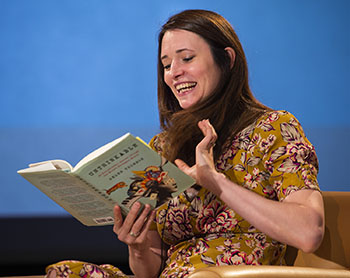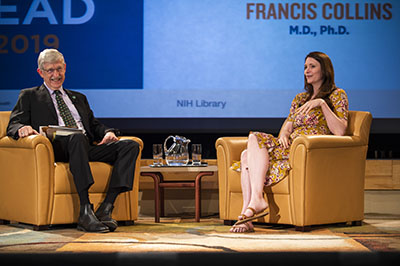Extraordinary Neural Circuits
NIH Big Read Author Helen Thomson
Imagine having a brain that enabled you to recall every event of every day in your past. Or a brain that caused you to constantly hear sounds or music, made you feel as if you were dead, or empowered you to feel others’ every sensation and emotion as if they were your own. These are but a few of the startlingly unusual brains that Helen Thomson writes about in her book, Unthinkable: An Extraordinary Journey through the World’s Strangest Brains (2018).

CREDIT: LISA HELFERT (LISAHELFERT.COM)
Author Helen Thomson, the featured guest at NIH’s Big Read in June, wrote about startling unusual brains in her book, Unthinkable: An Extraordinary Journey through the World’s Strangest Brains.
Thomson, a science journalist, was at NIH on June 7, 2019, for a conversation with NIH Director Francis Collins in a packed Masur Auditorium (Building 10) with a simultaneous live Facebook feed. The event was the culmination of the NIH Library’s 2019 NIH Big Read. In its third year, the program is designed to bring together NIH staff for discussions on a book of scientific interest. The Library arranged unlimited access to the eBook and audiobook versions and organized several hour-long discussion sessions on the main and outlying campuses.
Previous NIH Big Read books were Siddhartha Mukherjee’s The Gene: An Intimate History (in 2017) and Ed Yong’s I Contain Multitudes: The Microbes within Us and a Grander View of Life (in 2018).
In fact, Yong’s suggestion of Unthinkable during his 2018 NIH Big Read event was one of the reasons it was chosen for the 2019 Big Read.
As a writer at New Scientist magazine, Thomson had always been intrigued by brain research and admired books by Oliver Sacks that described patients with unusual neurological syndromes. Thomson’s discussions of case studies with neurologists led to a growing pile of interesting stories on her desk. One neurologist suggested she meet a particularly unusual patient—Tommy McHugh—whose story eventually became the genesis of her book. Tommy was an aggressive ex-con whose personality changed dramatically after a stroke damaged his brain. He became a painter and a poet and “felt emotions he had never experienced before, saw numbers in trees, spoke mostly in rhyme, and would not hurt a fly,” as Thomson describes it.
Besides describing extraordinary cases, Thomson wanted to write about them from a nonclinical perspective—to meet patients in their own environments and know more about how their unusual brains affected their lives and personalities on a day-to-day basis. She was also interested in exploring how the developments in neuroscience in the past 40 years have changed the diagnosis, treatment, and social perceptions of such cases.
Sometimes her research put her in dangerous situations such as when she was interviewing a patient (named Matar) who suffered from a rare psychiatric disorder called clinical lycanthropy. A syndrome featured in ancient myth and modern Harry Potter books, lycanthropy is a real-life condition in which a person has the delusion he is turning into an animal. Matar, who was being treated for schizophrenia, had—unbeknownst to his doctors—stopped taking his medication. During Thomson’s interview with him, he began to growl menacingly, clench his hands into claws, and talk about attacking the people in the room because he perceived them as threatening lions. It was a disturbing experience for everyone. Luckily, Matar didn’t actually attack anyone.

CREDIT: LISA HELFERT (LISAHELFERT.COM)
Masur Auditorium was packed with NIHers eager to hear the conversation between NIH Director Francis Collins and writer Helen Thomson at the NIH Big Read event.
Most patients, said Thomson, feel a huge sense of relief when their syndrome is identified and named, despite finding out that their brains are “different.” They were enthusiastic participants in the scientific research process and Thomson’s interviews and were excited to have their syndromes better known. Collins pointed out that many of the syndromes described in her book were, in milder forms, familiar to most people, such as the phenomenon of getting lost. The more severe form is a condition called “developmental topographical disorientation disorder,” an inability to make and use a mental map of one’s surroundings. Thomson agreed that there was no clear dividing line between extraordinary and normal brains: The people in the book “had extreme versions of traits we all possess,” she said. “We all sit on the spectrum.”
Neurological methods that can identify real-time changes in the brain are in development, said Collins, and could change our understanding of the anatomic and physiological basis for unusual behaviors and abilities. Noninvasive brain stimulation and recording methods may result in discoveries that could lead to treatments for unusual syndromes as well as help boost normal cognition, for example, increasing attention span or improving the ability to solve math problems, said Thomson.
She mentioned some tricks for navigation and memory training that could be useful to everyone. To avoid getting lost, for example, she suggested looking behind you when you are walking around a new city to help memorize the environment from a different perspective, as animals do naturally in new environments.
Thomson’s advice for aspiring science journalists and anyone interested in science communication is to ask three questions when framing a story: Is this new? How is it relevant to people’s lives? And would you want to tell your friends about it?
Many extraordinary brains are described in Unthinkable, but as Thomson read from the ending of the book, “We all possess a remarkable feat of neural engineering that produces an unpredictable life that is utterly unique.”
To watch a videocast of Thomson’s June 7, 2019, NIH Big Read presentation, go to https://videocast.nih.gov/launch.asp?27602.
This page was last updated on Thursday, March 31, 2022
